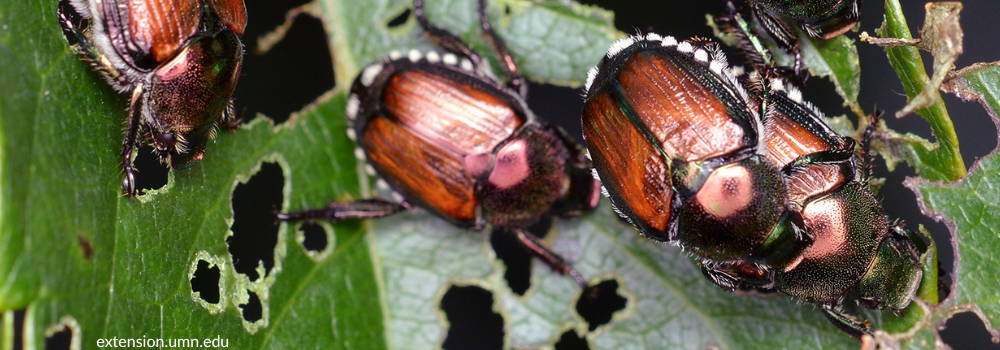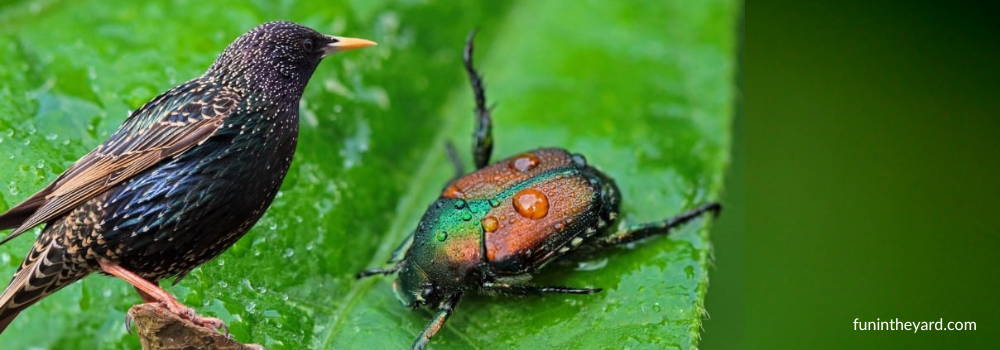What Attracts Japanese Beetles
The Japanese beetle has become a major pest problem in the United States due to its destructive eating habits and generalist nature. The adult beetle that eats a lot of plants is about 3/8" long and has a pair of copper-coloured wing covers and a metallic green body.
Adult Japanese beetles have five tiny, white tufts of “hair” under their wing covers. They also have another tuft of hair at the end of their abdomen.
Reproduction
Japanese beetles can live for up to two months. They are most active from June to August/September. Adult females usually lay eggs on pastures, golf courses and lawns, but they may also deposit their eggs in agricultural fields. They can lay up to 60 eggs at a time.
What Plants are Japanese Beetles Attracted To
To understand what attracts Japanese beetles, you must know their life cycles. Adult beetles are attracted to more than 300 types of plants and usually feed on the flowers, leaves and fruits of birch, apple trees, cherry, hollyhock, crab apple, soybean, rose bush and raspberries.
They attack in large groups and eat the entire leaf, excluding the veins. This feeding practice is called skeletonization. Adult beetles usually feed in the morning.
The feeding habits of these beetles are extremely destructive, especially during their larval stage. When the larvae hatch, they start feeding on the root of nearby plants.
The Japanese beetle grubs live underground. You will know that you have them when you see brown spots on your turf as they have been feeding on grassroots.
The grubs burrow underground during the winter and remain there until spring. Then, they will start feeding once more until they enter their pupal stage.
They will emerge from the ground a couple of weeks later as adults. So, what scent attracts Japanese beetles? Well, almost any tree or plant attracts them. The beetle feeds on rose bushes, birch trees, crape myrtle trees, fruit trees and linden trees.
What Trees Attract Japanese Beetles
Japanese beetles feed on a wide range of trees and will often eat the entire leaf, leaving only the veins. When the infestation is severe, the leaves of your trees may fall prematurely.
These pests are particularly fond of the following trees:
Crab apple
Norway maple
Crape myrtle
Japanese maple
Birch
Weeping cherry
Little leaf linden
Japanese maple
Ornamental cherry
Purple leaf plum
What Flowers Attract Japanese Beetles?
Japanese beetles are attracted to pretty much everything in the garden, but there are some flowers that they are particularly fond of. Some of these flowers include:
Clematis
Lily
Zinnia
Hibiscus
Sunflower
Daisy
Roses
Dahlia
Morning glory
Evening Primrose
Cardinal Flower
Hollyhock
Gladiolus
Peony
How to Get Rid of Japanese Beetles
The right timing for controlling these pests depends on the life cycle that you are trying to deal with. For example, you should attack the larvae in late summer or fall when they are maturing.
If you want to use chemicals or handpick them, you should do it in late July, May, or June because this is the period when they are actively eating plants.
The materials that you will need depend on the method that you are going to use to eliminate them and the stage they are in. However, you will not be able to get rid of them completely.
More of them will probably visit your garden because they are attracted to the scent of dead beetles and damaged leaves. And although they have natural enemies like birds and predatory flies and wasps, the population of these predators is not large enough to control the beetle population.
Therefore, you will need to use one or several hands-on methods to control them. Adult Japanese beetles only live for a month or two, so you should not use harsh chemicals immediately unless you are dealing with severe infestations.
Here are some of the most effective methods on how to get rid of Japanese beetles:
Insecticidal Soap
Insecticidal soaps can kill adult beetles only if you spray them directly on the beetles. The soap does not have residual effects, so the beetles that are not sprayed directly will not be killed. Insecticidal soaps, however, may kill helpful insects in the process.
We recommend the use of Green Earth Insecticidal Soap RTU 1L.
Handpicking
The best way to get rid of Japanese beetles is to remove them by hand. You can either crush them between your fingers or pick them off the plants and drop them in a jar of soapy water where they will drown.
They usually feed in large groups, so you might even fill your jar with Japanese beetles. However, you will need to repeat this process every few days while the infestation lasts.
Pesticides
Synthetic pesticides can kill adult Japanese beetles and their grubs, but you need to spray them in large volumes. However, using pesticides will pollute the surroundings and kill other insects as well.
Neem oil is a much better option because it contains pyrethrin. It is a biodegradable substance obtained from chrysanthemums.
You need to apply pyrethrin insecticides directly on the Japanese beetles because it will harm other insects as well. However, pyrethrin insecticides do not have residual effects on the environment. Thus, it is safe to use.
Pesticides that we recommend for you to use are Scotts Grub B Gon Grub Killer 1.40kg and Botanical Plant & Flower Liq Insect Killer 950ml.
Chemicals
You can use chemicals to kill the grubs. This is usually done by applying a granular grubicide to turfs in late fall or summer when the larvae are moving upwards to eat the roots of the grass. Grub baits are slightly controversial because they are synthetic chemicals.
Most of them, however, are considered mildly toxic by the Environmental Protection Agency (EPA). Grub baits are relatively safe to use if they are applied properly and exactly as the label directions say.
They affect various grubs and beetles that attack lawns, but they will not kill beneficial organisms like earthworms. Just make sure that you are not using products that contain Sevin because it does kill beneficial organisms.
If your lawn is suffering from repeated severe Japanese beetle infestations, you should check the ground in late summer by lifting a 1 sq ft section of your turf. And if you see a large population of grub in this area, you should treat your garden with grub control.
Not all gardens with a beetle problem are infested with a large population of grub. It is possible that the grubs hatched in your neighbour’s garden and found their way to your lawn with little effort.
Safer options that we have for you are POT-It Plant Multi Insect RESIDUAL 400gr and Botanical Green House Vegetables BUG KILLER 950ml.
Nematodes and Milky Spore
Beneficial nematodes and milky spore can help control the grubs in your garden, but they work slowly, and it can take years before you fully enjoy their benefits.
Nematodes are small, microscopic worms that live in the soil. Since nematodes might die when exposed to direct sunlight, you should apply them at night or during a cloudy day.
Milky spores, on the other hand, are natural live organisms that can be applied to your lawn. Grubs that are infected with milky spores will die within a week or three. The organisms will proliferate and spread in the soil as the grubs decompose.
Milky spores can protect your lawn against Japanese beetles for over 20 years once they are fully established in the ground. However, it can take up to 5 years for these organisms to become completely established in colder climates. You can apply beneficial nematodes and milky spores at the same time to create a long-term solution to Japanese beetle problems.
You might be tempted to use Japanese beetle traps when you are dealing with these pests, but you should use them with caution. Pheromone beetle traps do attract beetles, but you will probably have more beetles in your garden than before. These traps were designed to track how many beetles were on the lawn and when they arrived. They are not designed to eradicate Japanese beetles.
How to Control Japanese Beetles
When there are Japanese beetles on your lawn, you might have more problems as well. That is because moles will come to your garden to eat the grubs hiding underground. That is why you should learn how to control Japanese beetles and their grubs to eliminate your mole problem as well.
If you have an ongoing problem Japanese beetle problem, consider filling your garden with plants that can deter them. Some of these plants include:
Hemlock
Holly
Arborvitae
Firs
Boxwood
Rhododendron
Junipers
Dogwood
Magnolia
Lilac
Redbud
Oaks
Red maple
Pines
Natural Predators
Some domestic animals such as chickens, guinea hens and ducks eat Japanese beetles, so consider bringing them into your lawn. Many wild animals are voracious eaters of Japanese beetles as well.
Catbirds, cardinals, and catbirds feed on Japanese beetles. Mammals like raccoons, moles, shrews, skunks, and opossums will eat the grubs, but they will dig up your garden as well.
Conclusion
Although it is impossible to eliminate Japanese beetles, you can still protect your plants from them and keep your lawn healthy. You also need to consider your landscape plants when you are dealing with adult Japanese beetles.
For example, you do not need to spray mature shrubs and mature trees because they can tolerate the feeding habits of adult Japanese beetles and will grow new leaves again next year. But if you are dealing with an ongoing beetle problem, consider filling your garden with plants that deter Japanese beetles. You should also get rid of their food source by eliminating plants that attract the beetles.



